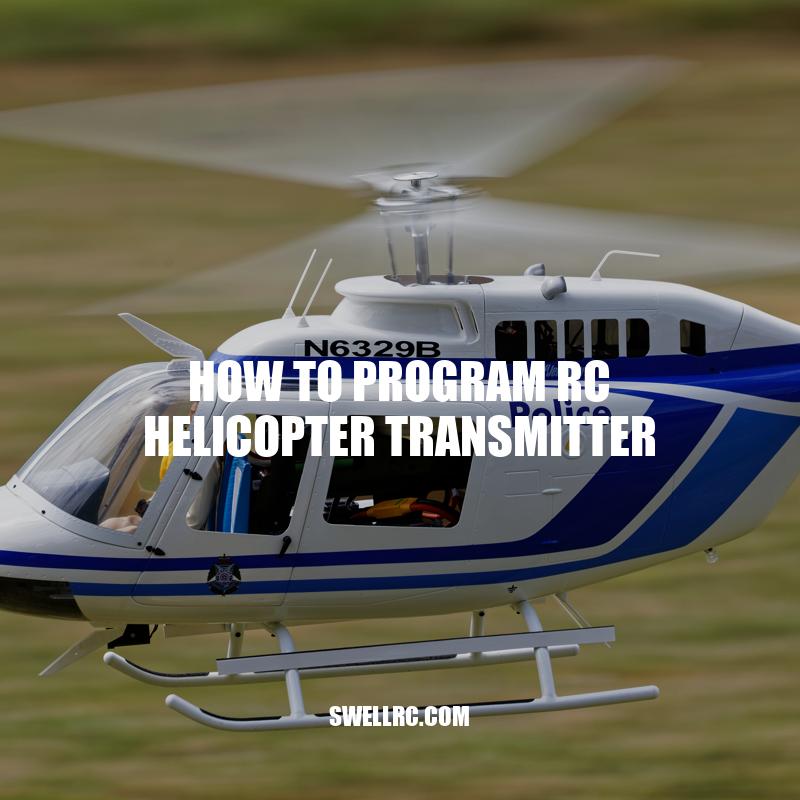Mastering RC Helicopter Transmitter Programming: Tips and Steps
Rc helicopters are great examples of remote-controlled machines that require a transmitter to operate successfully. A transmitter is a crucial component that allows a pilot to make maneuvers and controls the helicopter remotely from the ground. Programming an rc helicopter transmitter can be a daunting task, especially for beginners. However, with the right knowledge and skills, programming can be an exciting and rewarding experience. Transmitters come in different types, models and styles, ranging from simple two-channel models to advanced 12-channel types with robust programming features. Knowing the different transmitter types and how to program them correctly is essential in operating rc helicopters. This article will provide a detailed guide on how to program rc helicopter transmitters to ensure easy and safe remote control of the machine.
Types of Rc Helicopter Transmitters
RC helicopter transmitters come in various models and types; understanding each type of transmitter is vital, as each has a different functionality and capability. Here are some of the common types of rc helicopter transmitters:
- 2-channel transmitters: operate the throttle and the tail (yaw) of the helicopter.
- 3-channel transmitters: operate the throttle, the tail (yaw), and the elevator, which moves the helicopter up and down.
- 6-channel transmitters: operate the four main functions, which include the throttle, tail (yaw), elevator, and ailerons or roll.
- 12-channel transmitters: have extensive programming features and can operate multiple rc helicopters with advanced features, including customization.
Understanding the differences between each type will help you identify which transmitter type will suit your needs. There are many websites and products available that can provide more detailed information on the different types of RC helicopter transmitters. For instance, you can visit HorizonHobby to check out their wide range of rc helicopter transmitters.
What are the different types of RC transmitters?
There are generally three types of RC transmitters:
- Basic RC transmitters: These are typically included with low-cost RC vehicles and are meant for beginners. They usually have limited channels which limit their ability to control advanced features of the RC vehicle.
- Sport RC transmitters: These are the most common type of transmitter used by hobbyists. They have more channels than basic transmitters, allowing for greater control over an RC vehicle. They also offer a wider range of features.
- Professional RC transmitters: These are high-end transmitters that are typically used by professionals. They offer advanced features and can handle multiple RC vehicles at once.
If you’re interested in purchasing an RC transmitter, websites such as Amazon, HobbyKing, and Tower Hobbies offer a wide variety of transmitter options.
Steps to Program RC Helicopter Transmitters
Programming an RC helicopter transmitter is essential for the smooth functioning of a helicopter. Here are some steps to guide you through the process:
- Read the manual – this will help you understand the general process and specific instructions for your model.
- Power on your RC heli – Make sure your RC helicopter is powered on, so it can sync with the transmitter.
- Enter programming mode – Access the programming mode by following instructions specified for the model/brand of the transmitter. This may differ between models and brands.
- Configure the transmitter – Assign each channel to a specific operation (throttle, rudder, elevator or any other control functions depending on the model).
- Saving the settings – Once you have configured the transmitter parameters settings, save your settings and reset your RC helicopter controller, so they can synchronize with each other.
It is essential to note that programming RC helicopter transmitters could differ from one model and brand to another. Take particular care to understand the specific instructions for your particular model since deviation from the instructions could harm your RC helicopter or cause it to malfunction.
RC enthusiasts can also find beneficial resources and additional guidelines concerning programming RC helicopter transmitters on various online forums dedicated to RC hobby enthusiasts. There are also online tutorials that help new users learn how to program an RC helicopter transmitter. Below is a simple table listing some of the available online tutorials and forums:
| Website/Forum | Description | |
|---|---|---|
| Helifreak Forum | A forum where users can get general and specific information relating to RC helicopters and programming of RC helicopter transmitters. Most users are experts in the field. | |
| RCGroups.com | Another forum that provides helpful information, tips and techniques for RC enthusiasts, including programming RC helicopter transmitters. | |
| Youtube | There are many tutorial videos giving step by step guides on programming RC helicopter transmitters, including how to troubleshoot various debugging issues. |
Tips on Programming RC Helicopter Transmitters
Programming an RC helicopter transmitter may look complicated at first, but with these useful tips, it may become easy as you progress:
- Understand the transmitter modes – Most RC helicopter transmitters have the mode 1 and mode 2. Identify which mode is comfortable for you to use.
- Learn about the mixing concept – Knowing how to mix your controls on your transmitter is important when programming something complex like swashplate mixing.
- Utilize the model memory function – Save your settings on your RC helicopter transmitter to avoid repetition of setting adjustments every time you want to fly your helicopter.
- Get familiar with throttle curves – Throttle control helps regulate the power supplied to the rotor blades. Understanding the throttle curve will help to enhance the power output to the rotor blades.
Also, it is advisable to get a quality transmitter as it can make your RC helicopter programming experience more comfortable.
A good example of high-quality rc helicopter transmitters is the Spektrum DX6E. It is a 6-channel transmitter with functionalities like mixing, subtrim, and custom switch assignments. Users can also save five customized model memory entries. In addition, it has a 128 × 64 pixel display screen, providing an efficient way of programming, and also supports mode 1 and mode 2 depending on the user’s preferences.
There are other reliable and top-performing models of rc helicopter transmitters on the market, including FrSky Tarannis X9D and Futaba 6J Transmitter. It is essential to understand your needs before purchasing a transmitter that suits you.
How many channels does an RC helicopter need?
An RC helicopter typically requires at least 4-6 channels for basic flight control. These channels include:
- Throttle: controls the altitude and rotation of the helicopter rotor blades
- Pitch: controls the angle of the rotor blades, which affects the helicopter’s forwards and backwards movement
- Roll: controls the side-to-side movement of the helicopter
- Yaw: controls the rotation of the helicopter around its vertical axis
- Optional channels may include features such as lights, cameras or additional functionality such as autopilot
It’s important to note that more channels don’t necessarily mean better performance. The right number of channels will largely depend on the type of helicopter and the pilot’s skill level.
For more information on RC helicopters and other remote-controlled toys, visit websites such as rcplanet.com or horizonhobby.com.
Troubleshooting RC Helicopter Transmitter for Programming Issues
As much as RC helicopter programming is not as easy as it looks, various troubleshooting techniques can solve common programming complications.
- Check the manual for solutions – Most RC helicopter manuals have solutions to common programming problems.
- Check the transmitter settings – Ensure you follow step by step during the programming process and crosscheck the settings and configurations for any mistakes.
- Check the battery – Every time unexpected programming issues crop up, check the transmitter batteries. Dead batteries may impact the transmitter signal.
- Perform a factory reset – This works when the rc helicopter transmitter is experiencing abnormal glitching or other strange behavior after programming. Check the manual for how to perform a factory reset on your specific model.
In case the above troubleshooting tips do not solve the problem, one can consider contacting a professional technician. Although this may attract an extra cost, it guarantees accuracy and effectiveness in resolving programming issues.
There are also several online forums and communities for rc helicopter enthusiasts that cover helpful troubleshooting, tips, and tricks on programming rc helicopter transmitters. Check out forums like helifreak.com, rcgroups.com and rc-heli.com to help solve your RC helicopter programming woes.
Practice and Get Help When Needed
As with any new skill, practice is essential for mastering RC helicopter programming. Here are some tips to help you improve your programming skills:
- Practice on a simulator – Simulators are an effective way to practice programming without risking damage to your RC helicopter. There are various simulators available online, such as ClearView and RealFlight, to help you hone your programming skills.
- Practice programming specific functions – Practice programming specific functions like mixers or throttle curves to get more familiar with the programming process.
- Get help from knowledgeable individuals – Reach out to fellow RC enthusiasts online or offline for help if you get stuck in the programming process.
In case you need more formal training, several institutions offer training and certification. You can check out the following websites for more information:
- Model Aircraft – This site has information on institutions that offer training and guides on becoming an RC pilot.
- Helifreak – This site has educational resources and discussion forums dedicating to RC helicopters and programming.
- RC Universe – This site has information on RC helicopter events, training manuals, and magazines where you can learn more about programming.
With practice and assistance, programming your RC helicopter transmitter should become more manageable. So don’t give up! Keep practicing and seek help when you need it.
How long does it take to learn to fly an RC helicopter?
- The time it takes to learn to fly an RC helicopter varies depending on the individual’s natural ability, the quality of the helicopter, and the complexity of the instructions.
- On average, it takes about 10 hours of practice to become comfortable with the basic maneuvers, such as hovering, takeoff and landing, and simple turns.
- More complex maneuvers, such as loops and rolls, can take several months of dedicated practice to master.
- It’s important to start with a beginner-friendly helicopter and to follow the manufacturer’s instructions closely to avoid damaging the helicopter or causing injury.
- Online tutorials and instructional videos can be helpful resources for learning to fly an RC helicopter.
Conclusion
Programming RC helicopter transmitters may seem intimidating at first, but by reading the instructions carefully and practicing, you will master it in no time. Learning to program your RC helicopter transmitter is essential because it will enable you to customize your helicopter to your personal preferences, which will make your flying experience more enjoyable.
In this article, we reviewed the basics of RC helicopter transmitters, the types of transmitters available, and how to program them. We also discussed troubleshooting and provided tips and resources to help you with programming. With a little practice and assistance, you can program your RC helicopter transmitter with ease, enhancing your RC helicopter flying experience.
So, what are you waiting for? Get out there and start programming your RC helicopter transmitter today! And remember, if you get stuck, don’t give up; try again, ask for help, and keep practicing. With persistence, you will soon become an expert in programming your RC helicopter transmitter.



